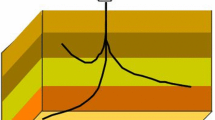Abstract
Wells are seldom modeled explicitly in large scale finite difference reservoir simulations. Instead, the well is coupled to the reservoir through the use of a well index, which relates wellbore flow rate and pressure to grid block quantities. The use of an accurate well index is essential for the detailed modeling of nonconventional wells; i.e., wells with an arbitrary trajectory or multiple branches. The determination of a well index for such problems is complicated, particularly when the simulation grid is irregular or unstructured. In this work, a general framework for the calculation of accurate well indices for general nonconventional wells on arbitrary grids is presented and applied. The method entails the use of an accurate semianalytical well model based on Green's functions as a reference single phase flow solution. This result is coupled with a finite difference calculation to provide an accurate well index for each grid block containing a well segment. The method is demonstrated on a number of homogeneous example cases involving deviated, horizontal and multilateral wells oriented skew to the grid. Both Cartesian and globally unstructured multiblock grids are considered. In all these cases, the method is shown to provide results that are considerably more accurate compared to results using standard procedures. The method is also applied to heterogeneous problems involving horizontal wells, where it is shown to be capable of approximating the effects of subgrid heterogeneity in coarse finite difference models.
Similar content being viewed by others
References
J. Alvestad, K. Holing, K. Christoffersen, O. Langeland and O. Stave, Interactive modeling of multiphase inflow performance of horizontal and highly deviated wells, SPE paper 27577, presented at: The European Petroleum Computer Conference, Aberdeen, UK, 15-17 March 1994.
J. Arvo, Graphic Gems, Vol. II (Academic Press, Boston, MA, 1991).
D.K. Babu and A.S. Odeh, Numerical simulation of horizontal well, SPE paper 20161, presented at: The SPE Middle East Oil Show, Bahrain, 16-19 November 1991.
D.K. Babu and A.S. Odeh, Productivity of a horizontal well, SPERE 4 (1989) 417-21.
C. Deutsch and A.G. Journel, GSLIB: Geostatistical Software Library and User's Guide, 2nd ed. (Oxford Univ. Press, Reading, MA, 1998) p. 368.
Y. Ding, A generalized 3D well model for reservoir simulation, SPE J. 1 (1996) 437-450.
Y. Ding and L. Jeannin, A multi-point flux approximation scheme for well modelling in reservoir simulations, in: Proc. of the 7th European Conf. on the Mathematics of Oil Recovery, Baveno, Italy, 5-8 September 2000.
L.J. Durlofsky, An approximate model for well productivity in heterogeneous porous media, Math. Geol. 32 (2000) 421-38.
M.J. Economides, C.W. Brand and T.P. Frick, Well configurations in anisotropic reservoirs, SPEFE 11 (1996) 257-62.
L.S.-K. Fung, W.L. Buchanan and R. Sharma, Hybrid-CVFE method for flexible grid reservoir simulation, SPE paper 25266, presented at: The SPE Reservoir Simulation Symposium, New Orleans, LA, 28 February-3 March 1993.
M.F. Hawkins, A note on the skin effect, Trans. AIME 207 (1956) 356-57.
P. Jenny, C. Wolfsteiner, S.H. Lee and L.J. Durlofsky, Modeling flow in geometrically complex reservoirs using hexahedral multiblock grids, SPE J. 7 (2002) 149-57.
R.A. Klausen and I. Aavatsmark, Connection transmissibility factors in reservoir simulation for slanted wells in 3D grids, in: Proc. of the 7th European Conf. on the Mathematics of Oil Recovery, Baveno, Italy, 5-8 September 2000.
S.H. Lee and W.J. Milliken, The productivity index of an inclined well in finite-difference reservoir simulation, SPE paper 25247, presented at: The SPE Symposium on Reservoir Simulation, New Orleans, LA, 28 February-3 March 1993.
O. Mascarenhas and L.J. Durlofsky, Coarse scale simulation of horizontal wells in heterogeneous reservoirs, J. Petrol. Sci. Engrg. 25 (2000) 135-47.
S. Mochizuki, Well productivity for arbitrarily inclined well, SPE paper 29133, presented at: The SPE Reservoir Simulation Symposium, San Antonio, TX, 12-13 February 1995.
N. Morita, S.P. Singh, H.S. Chen and D.L. Whitfill, Three-dimensional well model pre-processors for reservoir simulation with horizontal and curved inclined wells, SPE paper 20718, presented at: The SPE Annual Technical Conference and Exhibition, New Orleans, LA, 23-26 September 1990.
L.-B. Ouyang and K. Aziz, A general single-phase wellbore/reservoir coupling model for multilateral wells, SPERE&E 4 (2001) 327-335.
C.L. Palagi and K. Aziz, The modeling of vertical and horizontal wells with Voronoi grid, SPE paper 24072, presented at: The SPE Western Regional Meeting, Bakersfield, CA, 30 March-1 April 1992.
D.W. Peaceman, Interpretation of well-block pressure in numerical reservoir simulation with nonsquare grid blocks and anisotropic permeability, SPE J. (1983) 531-543.
D.W. Peaceman, Interpretation of well-block pressures in numerical reservoir simulation. Part 3–Off center and multiple wells within a well-block, SPERE 5 (1990) 227.
M.P. Reddy, M.K. Deb, J.M. Bass and H. Ning, Numerical simulation of non-conventional wells using adaptive finite element analysis, Comput. Methods Appl. Mech. Engrg. 150 (1997) 109-124.
P.H. Valvatne, L.J. Durlofsky and K. Aziz, Semi-analytical modeling of the performance of intelligent well completions, SPE paper 66368, presented at: The SPE Reservoir Simulation Symposium, Houston, TX, 11-14 February 2001.
C. Wolfsteiner, L.J. Durlofsky and K. Aziz, Approximate model for productivity of nonconventional wells in heterogeneous reservoirs, SPE J. 5 (2000) 218-226.
C. Wolfsteiner, L.J. Durlofsky and K. Aziz, Efficient estimation of the effects of wellbore hydraulics and reservoir heterogeneity on the productivity of nonconventional wells, SPE paper 59399, presented at: The SPE Asia Pacific Conference, Yokohama, Japan, 25-26 April 2000.
Author information
Authors and Affiliations
Rights and permissions
About this article
Cite this article
Wolfsteiner, C., Durlofsky, L.J. & Aziz, K. Calculation of Well Index for Nonconventional Wells on Arbitrary Grids. Computational Geosciences 7, 61–82 (2003). https://doi.org/10.1023/A:1022431729275
Issue Date:
DOI: https://doi.org/10.1023/A:1022431729275




